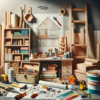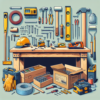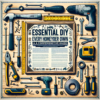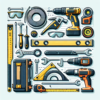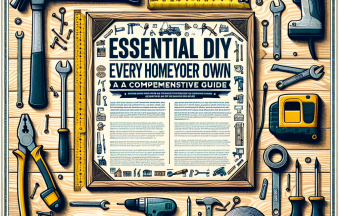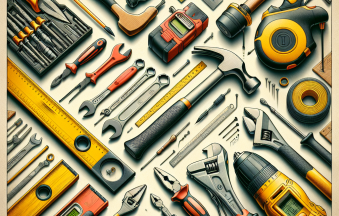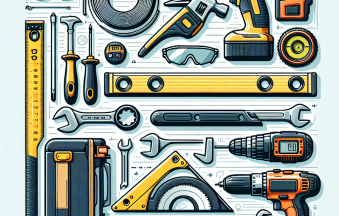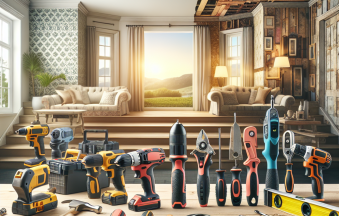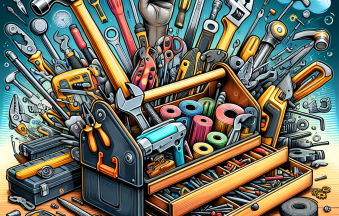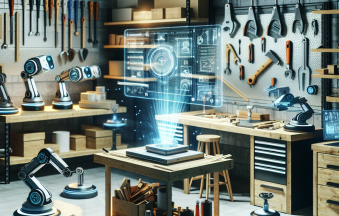Overview of DIY Tools
Diving into a DIY project might seem like an overwhelming endeavor, whether you’re refreshing a room’s color, constructing a new shelf, or just swapping out a light bulb. Nevertheless, knowing the fundamental DIY tools and instruments can make the task considerably easier. In this article, we’ll examine various types of DIY tools—from household instruments and construction materials to electrical devices and more—emphasizing useful tips to empower you as you take on your projects with assurance.
Household Instruments: The Fundamentals
Your adventure into the realm of DIY starts with the appropriate household instruments. This section encompasses basic tools such as hammers, screwdrivers, pliers, and measuring tapes. They form the foundation of any DIY toolkit.
Essential Home Instruments
- Hammer: The quietly important tool for home maintenance, vital for driving nails and light demolition tasks.
- Screwdriver Set: Both flat-head and Phillips screwdrivers will meet most of your fastening requirements.
- Pliers: Perfect for grasping, twisting, and cutting wires or small items.
- Tape Measure: Precise measurements are vital; always keep a reliable tape measure accessible.
Construction Materials: Forming Structure
When it comes to constructing or renovating, selecting the correct materials is crucial. Construction materials can consist of timber, drywall, and insulation products.
Selecting Suitable Materials
Opt for high-grade timber for structural endeavors and don’t underestimate the significance of insulation in regulating your home’s temperature. Ensure you plan according to your project’s unique requirements; this will conserve both time and funds.
Electrical: Energizing Projects
Whether you’re repairing a malfunctioning outlet or installing a ceiling fixture, possessing the appropriate electrical tools is vital. Safety ought to be your primary concern in this section.
Key Electrical Instruments
- Multimeter: An essential tool for measuring voltage, current, and resistance.
- Wire Strippers: Ideal for eliminating insulation from electrical wires.
- Voltage Tester: Always check circuits before working on them to prevent electrical shocks.
Hardware & Fasteners: The Minor Details Count
Do not overlook the significance of hardware and fasteners in your tasks. Screws, nails, anchors, and brackets provide the binding force that holds your projects together.
Selecting Fasteners Carefully
Be aware of the different kinds of screws available—such as wood screws, sheet metal screws, etc.—and choose depending on your project needs. Always maintain a variety of screws and nails on hand to prepare for any scenario.
Kitchen & Bath: Revamping Areas
In DIY endeavors centered on the kitchen and bathroom, having the proper tools can enable you to manage tasks like plumbing and cabinetry efficiently.
Instruments for Kitchen & Bath Projects
The crucial tools for these spaces frequently include plumbing wrenches, caulk guns, and tile cutters. If you’re laying new tiles, a tile cutter can prove invaluable for achieving precise cuts.
Light Bulbs & LEDs: Illuminating Your Area
Lighting is essential in any residence. Selecting the appropriate light bulbs and fixtures can significantly alter the atmosphere and functionality of a space.
Advice for Picking Light Bulbs
Consider energy-efficient LED bulbs due to their longevity and minimal energy use. When swapping out bulbs, pay attention to lumens (brightness) and color temperature (warm versus cool light).
Lighting & Fans: Boost Aesthetics and Comfort
Integrating attractive lighting and ceiling fans can enhance your home while augmenting comfort. Fans also enhance airflow, making your living areas more inviting.
Installation Suggestions
Be sure to adhere to the manufacturer’s guidelines during installation. If you’re replacing a fixture, the procedure typically involves turning off the power, removing the old fixture, and properly securing the new one.
Measuring Tools: Accuracy is Important
No DIY venture is finished without precise measurements. Measuring instruments like laser levels and calipers can elevate your projects significantly.
Investing in Measuring Instruments
A laser level is particularly advantageous for ensuring straight lines in larger tasks, such as hanging shelves or cabinets. Always measure twice before cutting to avert costly errors.
Paint & Wall Supplies: Color Your Space
Painting can radically alter any room, and having the right tools can make all the difference. Brushes, rollers, and painter’s tape are crucial for achieving clean lines and a cohesive look.
Optimal Approaches for Painting
Begin by properly preparing your surfaces; clean, sand, and prime as needed. Use high-quality paint for the best outcome, and consider the finish based on your room’s purpose.
Final Recommendations for Successful DIY Projects
Regardless of your DIY endeavor, preparation is vital. Always plan in advance, review instructions, and gather materials beforehand. Don’t hesitate to seek assistance or guidance—DIY is about learning and developing as much as it is about the final product.


